Black Sheep Mesa & Ramah Area Flora |

|
|
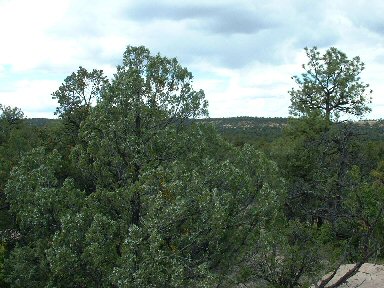
|
Above - Mixed life zone plants at 7400+ ft elevation. "Scrub" Gambel Oak (Querqus gambelii) with hint of fall color at left and Ponderosa Pine (Pinus Ponderosa)
at center are from the "Transition Zone", while the feathery light green Eastern Red Cedar (Juniperus virginianus) is just in front of a Pinyon (Pinus edulis) on far left. Both are from
the "Upper Sonoran Zone"
Below - A small stand of Beech family (Fragaceae) "scrub" Gambel Oak (Querqus gambelii).
These small trees are extremely valuable as "nurse" trees, which provide shade and mulch to retain moisture for other species. With enough moisture they may reach 30 ft. at maturity. |
Above - The light green almost feathery looking flat needle foliage of a living Cypress Family (Cupressaceae) Eastern Read Cedar (Juniperus virginianus)
next to the dead trunk of the same species.
Below - Two typical young short needle Pinyon (Pinus edulis)
trees in fore-ground. Mature trees can top 30 ft. and provide thousands of edible pine nuts every two to three years. |
Above - A Cypress Family (Cupressaceae) Rocky Mountain or Colorado Juniper (Juniperus scopulorum)
loaded with light bluish-green berries, which will feed lots of hungary birds. This species of juniper commonly grows in both life zones. Downhill to the right is a Ponderosa Pine.
Below
- Un-grazed high mesa grassland dotted with sage (fore-ground) and juniper (mid-ground) on El Moro National Monument at approximately 7300 ft. This is typical "Upper Sonoran Zone". Not obvious in the picture are common brouse shrubs in the Goosfoot Family
(Chenopodiaceae) Winter-fat (Eurotia lanata), Four-wing Saltbush (Atriplex canescens) and Black Greaswood (Sarcobatus vermiculatus).
The top of the sandstone bluff of "Inscription Rock" is well over 7700 ft. |
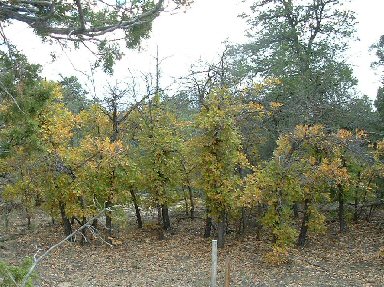
|

|
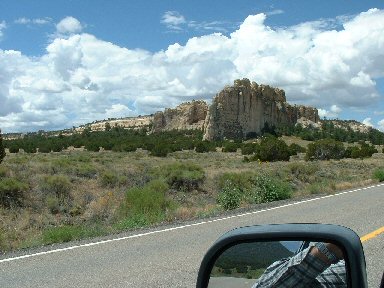
|

|
|
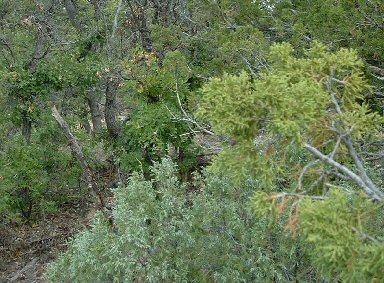
|
Above - Three Pine Family (Pinaceae) Ponderosa Pines (Pinus Ponderosa). Note typical rounded crown of 35+ ft Ponderosa on left. The clusters of six inch long
Ponderosa needles are obvious upper center.
Below - |
Above - Note cinnamon colored bark of Ponderosa Pine (Pinus Ponderosa). The bark also has a distinctive vanilla-like fragrance.
Below - |
Above - Parts of two Cypress Family (Cupressaceae) trees can be seen in close association with each other. An Eastern Read Cedar (Juniperus virginianus)
in lower center with a Rocky Mountain Juniper (Juniperus scopulorum) branch in front.
Below - |
| |
|
|
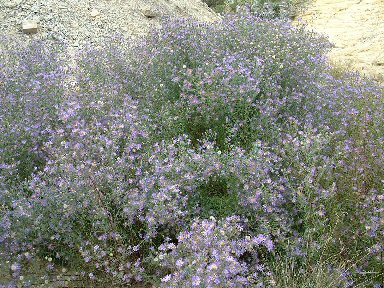
|
|
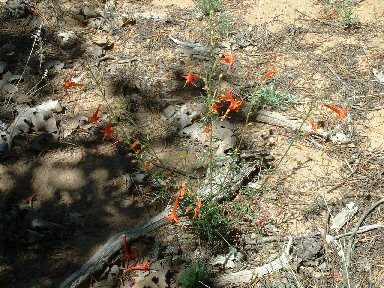
|
Above - Sunflower Family (Compositae), An atypically lush growth of Asters (Aster adscendens),
due to excessive run off. Close relatives to Purple Asters, these bloom sky blue in the Ramah area at elev. 7200+ ft.
Below - A mixed growth of Baby Aster (Aster hertifolius),
white flowers in fore ground with Scarlet Gilia (Gilia aggregata) mid-picture and Asters in upper right. |
Above - A more typical sparse growth of Aster. Blooms in spring and then after late summer rains.
Below - Pink Family (Caryophyllaceae) Mexican Campion, Mexican Pink or
Indian Pink (Silene laciniata), benefits form shade & extra run-off from boulders above. |
Above - Phlox Family (Polemoniaceae) Scarlet Gilia (Gilia aggregata now Ipomopsis aggregata)
abound in mid to late summer. Bright red trumpet shaped flower ends in five petaled star. Inside marked by yellow. Prominant after summer rains.
Below - Sunflower Family (Compositae)
Hairy Golden Aster (Heterotheca villosa). |

|
|

|
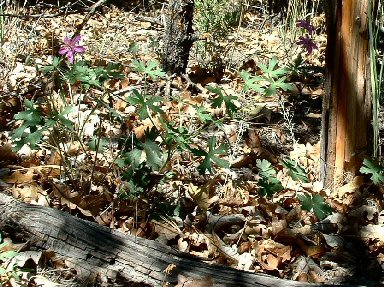
|
|
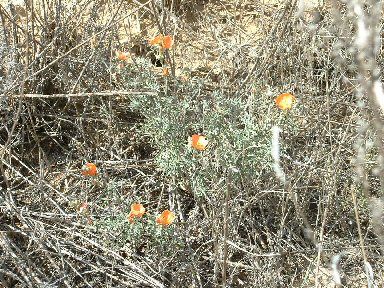
|
Above & Below - Geranium Family (Geraniaceae) Wild Geranium or Cranesbil (Geranium caespitosum), florishes under shade of Gambel Oak & Ponderosa Pine.
Note pale purple 5 petal blossom in upper left corner. Blooms June through September. Thick mulch of pine needles and oak leaves help retain moisture. |
Above & Below- Poppy Family (Papaveraceae) Mexican Poppy (Eschscholtzia californica), definately out of their natural life zone growing roadside at 7100+
ft. Normally considered a "Lower Sonoran Zone" desert plant. May have been seeded after road work. |
Above - Mallow Family (Malvaceae) Scarlet Globemallow (Sphaeralcea coccinia), is a small shrub-like plant. Blooms with orange hollyhock-like flowers all summer into
fall.
Below - Milkweed Family (Asclepiadaceae) Showy Milkweed (Asclepias speciosa) with small pale pink blossoms from May to September. |

|
|
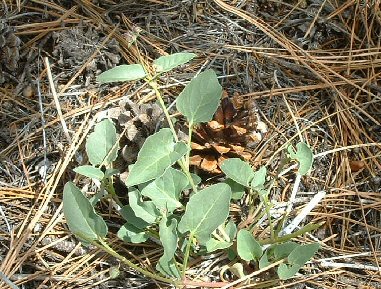
|

|
|
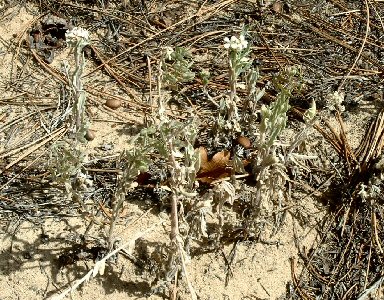
|
Above - Blue Gramma grass (Bouteloua gracilis) with it's distinctive horizontal head with dark seeds. It is the state grass of New Mexico and Colorado.
Below - May be Wolftail grass
(Lycurus setosus). |
Above - Waterleaf Family (Hydrophyllaceae) Phacelia or Wild Heliotrope (Phacelia corrugata) with a stray Sunflower Family (Compositae)
New Mexico Sunflower or Maximillian's Daisy (helianthus maximillianus).
Below - Firewheel (gaillardia aristata). |
|
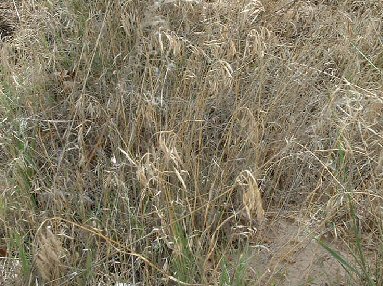
|
|
|
| |
|
|
Above -
Below - Saxifrage Family (Saxifragaceae) Golden Current (Ribes aureum). Obviously stressed by mid-summer heat as the dead Pinyon no longer provides
any shade and road cut now diverts uphill water away. |
Above - As yet unidentified (by me) "darned" yellow compositae (DYC).
Below
- Golden Current could feed lots of birds, but it also hosts White Pine Blister Rust, which may be what killed the Pinyon (Pinus edulis) next to it. |
|
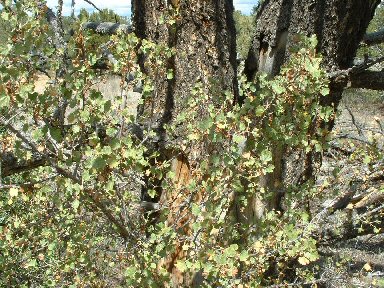
|
|
|
| |
|
|
| |
|
|
| |
|
|
| |
|
|
| |
|
|
| |
|
|
| |
|
|
| |
|
|
| |
|
|
